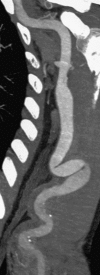Aneurysmal Degeneration of the Brachial Artery after Vascular Access Creation: Surgical Treatment Results
- PMID: 28804237
- PMCID: PMC5552899
- DOI: 10.1055/s-0037-1601872
Aneurysmal Degeneration of the Brachial Artery after Vascular Access Creation: Surgical Treatment Results
Abstract
True peripheral artery aneurysms proximal to a longstanding arteriovenous fistula is a well-recognized complication. Late aneurysmal degeneration is rare. This study analyzed the characteristics, therapeutic options, and outcomes of true donor brachial artery aneurysms (DBAA) after arteriovenous fistula (AVF) for hemodialysis. We retrospectively collected the data of patients with DBAA after AVF creation, surgically repaired between January 2001 and September 2015. We excluded patients with pseudoaneurysms, anastomotic aneurysms, and infected aneurysms. We recorded patient's demographics, type of access, aneurysm characteristics, symptoms, treatment, and follow-up. Ten patients were treated for aneurysmal degeneration of the brachial artery. Average aneurysm diameter was 37.5 mm. All cases had, at least, one previous distal AVF, ligated or thrombosed, at the time of diagnosis. The first access was created in mean 137 months before the diagnosis of DBAA. Nine patients had previous medical history of renal transplant and were under immunosuppressive therapy. All patients were symptomatic at the time of diagnosis. In all cases, the treatment was aneurysmectomy followed by interposition bypass. One patient developed a postoperative hematoma with the need of surgical drainage. At 50 months of follow-up, one patient was submitted to percutaneous angioplasty due to an anastomotic stenosis. No other complications occurred during the entire follow-up period (mean: 69 months). The pathogenesis underlying DBAA remains unclear. Increased blood flow after AVF creation, immunosuppressive therapy, and ligation/thrombosis of the AVF may contribute to aneurysm formation. Surgical treatment by aneurysmectomy and bypass, with autogenous conducts, is a safe and effective option.
Keywords: aneurysm; arteriovenous fistula; brachial artery; brachial artery aneurysm; fistula; hemodialysis; vascular access.
Figures



Similar articles
-
Aneurysmal degeneration of the inflow artery after arteriovenous access for hemodialysis.Eur J Vasc Endovasc Surg. 2014 Nov;48(5):592-6. doi: 10.1016/j.ejvs.2014.08.011. Epub 2014 Sep 12. Eur J Vasc Endovasc Surg. 2014. PMID: 25224122
-
Inflow Artery Aneurysmal Degeneration After Long Term Native Arteriovenous Fistula for Haemodialysis.Eur J Vasc Endovasc Surg. 2023 Dec;66(6):849-854. doi: 10.1016/j.ejvs.2023.08.063. Epub 2023 Sep 1. Eur J Vasc Endovasc Surg. 2023. PMID: 37659740
-
Aneurysmal degeneration of the donor artery after vascular access.J Vasc Surg. 2012 Apr;55(4):1052-7. doi: 10.1016/j.jvs.2011.10.112. Epub 2012 Feb 8. J Vasc Surg. 2012. PMID: 22322118
-
True Brachial Artery Aneurysm after Arteriovenous Fistula for Hemodialysis: Five Cases and Literature Review.Ann Vasc Surg. 2017 Feb;39:228-235. doi: 10.1016/j.avsg.2016.05.115. Epub 2016 Aug 12. Ann Vasc Surg. 2017. PMID: 27531094 Review.
-
[Aneurysms of the carotid arteries].Srp Arh Celok Lek. 1997 May-Jun;125(5-6):141-53. Srp Arh Celok Lek. 1997. PMID: 9265235 Review. Serbian.
Cited by
-
Brachial Artery Aneurysm After Fistula Ligation in a Hemodialysis Patient: A Case Report.Cureus. 2025 Jul 27;17(7):e88852. doi: 10.7759/cureus.88852. eCollection 2025 Jul. Cureus. 2025. PMID: 40881524 Free PMC article.
-
Aneurysmal Degeneration of the Brachial Artery Following Chronic Arteriovenous Fistula Ligation.EJVES Vasc Forum. 2023 Nov 11;61:8-11. doi: 10.1016/j.ejvsvf.2023.11.002. eCollection 2024. EJVES Vasc Forum. 2023. PMID: 38089843 Free PMC article.
-
Thrombosis related to true axillo-brachial arterial aneurysm following ligation of longstanding arteriovenous fistula for hemodialysis.J Vasc Surg Cases Innov Tech. 2023 Sep 27;9(4):101334. doi: 10.1016/j.jvscit.2023.101334. eCollection 2023 Dec. J Vasc Surg Cases Innov Tech. 2023. PMID: 37965111 Free PMC article.
-
Giant Brachial Aneurysm after Arteriovenous Fistula Ligation: A Review of the Different Surgical Approaches.Case Rep Nephrol Dial. 2020 May 27;10(2):57-64. doi: 10.1159/000507427. eCollection 2020 May-Aug. Case Rep Nephrol Dial. 2020. PMID: 32596260 Free PMC article.
-
Complications on the feeding artery after an arterio-venous fistula closure in patients after kidney transplantation - a national cohort study.Clin Kidney J. 2024 Nov 15;18(1):sfae360. doi: 10.1093/ckj/sfae360. eCollection 2025 Jan. Clin Kidney J. 2024. PMID: 39790445 Free PMC article.
References
-
- Gilmore J. KDOQI clinical practice guidelines and clinical practice recommendations--2006 updates. Nephrol Nurs J. 2006;33(05):487–488. - PubMed
-
- Vascular Access Work Group.Clinical practice guidelines for vascular access Am J Kidney Dis 200648(Suppl 1):S248–S273. - PubMed
-
- Hunter W. The history of an aneurysm of the aorta with some remarks on aneurysms in general. Trans Med Obstet Soc Phys Lond. 1757;1:323.
-
- Marzelle J, Gashi V, Nguyen H D, Mouton A, Becquemin J P, Bourquelot P. Aneurysmal degeneration of the donor artery after vascular access. J Vasc Surg. 2012;55(04):1052–1057. - PubMed
-
- Chemla E, Nortley M, Morsy M. Brachial artery aneurysms associated with arteriovenous access for hemodialysis. Semin Dial. 2010;23(04):440–444. - PubMed
LinkOut - more resources
Full Text Sources
Other Literature Sources

